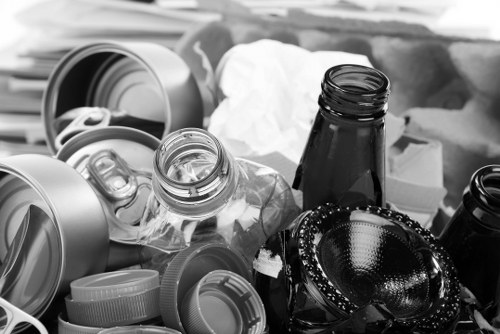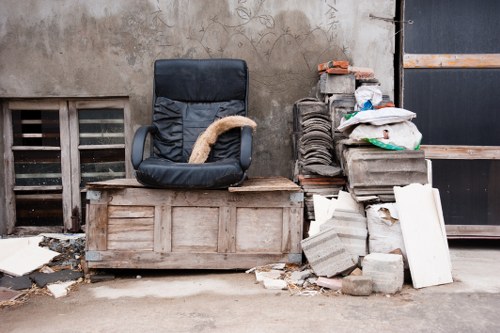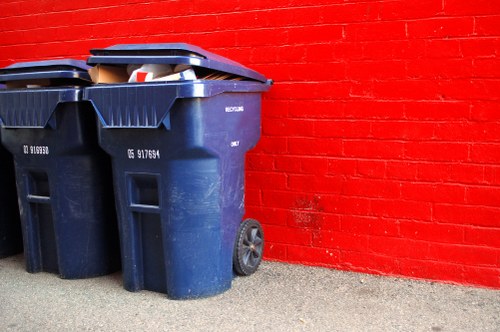Comprehensive Guide to Construction Waste Clearance in Twickenham
Managing construction waste is a critical aspect of any building project. In Twickenham, effective waste clearance not only ensures compliance with local regulations but also promotes environmental sustainability. This article delves into the best practices, benefits, and services available for construction waste clearance in Twickenham.
Construction projects generate a significant amount of waste, ranging from concrete and wood to metals and plastics. Proper disposal and recycling of this waste are essential to minimize environmental impact and avoid legal issues. Understanding the intricacies of construction waste clearance can lead to more efficient project management and cost savings.
Whether you are a contractor, builder, or homeowner undertaking a renovation, knowing how to handle construction waste is paramount. This guide provides a detailed overview of the processes involved, the types of waste generated, and the solutions available in Twickenham.

Understanding Construction Waste Clearance
Construction waste clearance refers to the process of removing and managing debris generated during construction, renovation, or demolition projects. This includes everything from small materials like nails and screws to large items like concrete slabs and timber. Proper clearance involves sorting, recycling, and disposing of waste in an environmentally responsible manner.
In Twickenham, local regulations dictate how construction waste must be handled. Compliance ensures that waste is managed safely and sustainably, reducing the impact on the community and the environment. Non-compliance can result in hefty fines and project delays.
Effective waste clearance reduces clutter on construction sites, creating a safer work environment. It also streamlines project workflows, allowing for more efficient use of space and resources.

Types of Construction Waste
1. Concrete and Masonry
Concrete and masonry waste are among the most common types generated in construction projects. This includes broken bricks, concrete chunks, and leftover mortar.
2. Wood
Wood waste encompasses offcuts, pallets, and discarded timber. It’s often repurposed or recycled to minimize environmental impact.
3. Metals
Metal waste includes steel, aluminum, and copper scraps. Metals are highly recyclable and can be repurposed for future construction needs.
4. Plastics and Insulation
Plastics used in construction, such as PVC pipes and insulation materials, require careful disposal due to their non-biodegradable nature.
5. Hazardous Materials
Hazardous waste includes substances like asbestos, paints, and solvents. Proper handling and disposal are crucial to ensure safety and regulatory compliance.

Benefits of Professional Waste Clearance Services
Engaging professional construction waste clearance services in Twickenham offers numerous advantages:
- Efficiency: Professionals have the expertise and equipment to manage waste swiftly and effectively.
- Compliance: Ensures all waste disposal adheres to local regulations and environmental standards.
- Cost-Effective: Reduces the risk of fines and project delays associated with improper waste handling.
- Environmental Responsibility: Promotes recycling and sustainable waste management practices.
- Safety: Maintains a clean and safe work environment, minimizing accidents and health hazards.
By utilizing professional services, construction projects can progress smoothly, with waste clearance seamlessly integrated into the workflow.

Steps Involved in Construction Waste Clearance
1. Assessment and Planning
Before commencing waste clearance, a thorough assessment of the site is conducted. This involves identifying the types and quantities of waste, planning the logistics of removal, and determining the appropriate disposal methods.
2. Sorting and Segregation
Waste is sorted into categories such as recyclable materials, non-recyclable waste, and hazardous substances. Proper segregation facilitates efficient recycling and disposal.
3. Collection and Transportation
Once sorted, the waste is collected and transported to appropriate facilities. Professional services ensure that transportation complies with safety and environmental regulations.
4. Recycling and Disposal
Recyclable materials are processed and reused, reducing the demand for new resources. Non-recyclable waste is disposed of responsibly in designated landfills or treatment centers.
5. Documentation and Compliance
Maintaining records of waste clearance activities is essential for regulatory compliance. Documentation ensures transparency and accountability throughout the process.

Regulations Governing Construction Waste in Twickenham
Twickenham adheres to strict regulations regarding construction waste management. These rules are designed to minimize environmental impact and promote sustainable practices. Key regulations include:
- Waste Classification: Categorizing waste to determine the appropriate disposal method.
- Recycling Mandates: Requirements to recycle specific types of materials, such as metals and plastics.
- Hazardous Waste Handling: Strict protocols for the disposal of hazardous substances to ensure public safety.
- Reporting Requirements: Obligations to document and report waste management activities to local authorities.
Compliance with these regulations not only avoids legal repercussions but also contributes to a healthier environment in Twickenham.
Choosing the Right Waste Clearance Service
Selecting a reliable construction waste clearance service in Twickenham involves considering several factors:
- Experience: Look for companies with a proven track record in managing construction waste.
- Services Offered: Ensure the service provider offers comprehensive solutions, including sorting, recycling, and disposal.
- Licensing and Certification: Verify that the company complies with local regulations and holds necessary certifications.
- Customer Reviews: Check testimonials and reviews to gauge the quality of service.
- Cost Transparency: Choose services that offer clear and competitive pricing without hidden fees.
Investing time in selecting the right service provider can lead to smoother project execution and better waste management outcomes.
Innovative Solutions in Waste Clearance
The construction industry is continually evolving, and so are the methods for waste clearance. Innovative solutions include:
- On-Site Recycling: Processes that allow for recycling materials directly on the construction site, reducing transportation needs.
- Waste-to-Energy Technologies: Converting waste materials into usable energy, thereby reducing landfill dependency.
- Digital Waste Tracking: Utilizing software to monitor and manage waste generation and disposal in real-time.
- Modular Construction: Designing buildings with standardized modules that minimize waste during construction and disposal.
Adopting these technologies can enhance the efficiency and sustainability of construction waste clearance in Twickenham.
Environmental Impact of Proper Waste Clearance
Effective management of construction waste has significant environmental benefits:
- Resource Conservation: Recycling reduces the need for new raw materials, conserving natural resources.
- Energy Savings: Recycling materials like aluminum and steel saves energy compared to producing them from scratch.
- Reduced Landfill Use: Proper waste management decreases the volume of waste sent to landfills, extending their lifespan.
- Lower Greenhouse Gas Emissions: Minimizing waste reduces emissions from transportation and landfill decomposition.
- Enhanced Biodiversity: Reducing waste pollution helps preserve local ecosystems and wildlife.
These environmental advantages highlight the importance of investing in quality construction waste clearance services.
Cost Factors in Waste Clearance
The cost of construction waste clearance in Twickenham depends on several factors:
- Volume of Waste: More waste generally incurs higher disposal and recycling costs.
- Type of Waste: Hazardous and non-recyclable materials may require specialized handling, increasing costs.
- Location: Accessibility and proximity to disposal facilities can affect transportation expenses.
- Service Frequency: Regular clearance services may be more cost-effective than one-time removals.
- Additional Services: Extra services like on-site recycling or waste sorting may come at an added cost.
Budgeting for waste clearance as part of the overall construction project can prevent unexpected expenses and ensure efficient resource allocation.
Tips for Minimizing Construction Waste
Reducing the amount of waste generated during construction can lead to significant cost savings and environmental benefits. Here are some tips:
- Accurate Planning: Detailed project planning helps in estimating the required materials accurately, reducing excess.
- Material Selection: Choose materials that can be easily reused or recycled.
- Efficient Design: Design structures to minimize waste, such as using modular components.
- Employee Training: Educate workers on waste reduction practices and proper material handling.
- Regular Audits: Conduct waste audits to identify areas where waste can be reduced.
Implementing these strategies can lead to a more sustainable construction process and lower waste clearance costs.
Future Trends in Construction Waste Clearance
The construction industry's future will likely see advancements in waste management technologies and sustainable practices:
- Automated Sorting Systems: Utilizing AI and robotics to sort waste materials more efficiently.
- Circular Economy Models: Designing buildings with the end-of-life reuse of materials in mind.
- Biodegradable Materials: Increasing use of materials that break down naturally, reducing environmental impact.
- Green Certifications: More projects will seek certifications that emphasize sustainable waste management.
- Collaborative Platforms: Digital platforms that connect builders with recycling facilities and waste management services.
Staying abreast of these trends will help stakeholders in Twickenham adopt more effective and sustainable waste clearance practices.
Conclusion
Construction waste clearance in Twickenham is a vital component of successful and sustainable building projects. By understanding the types of waste, adhering to local regulations, and utilizing professional services, projects can minimize environmental impact, reduce costs, and enhance overall efficiency.
Implementing best practices in waste management not only benefits the immediate construction site but also contributes to the broader goal of environmental preservation. As the industry evolves, embracing innovative solutions will ensure that construction waste clearance remains effective and sustainable.
**Contact us today** to learn more about our construction waste clearance services in Twickenham and take the first step towards a cleaner, greener construction project.